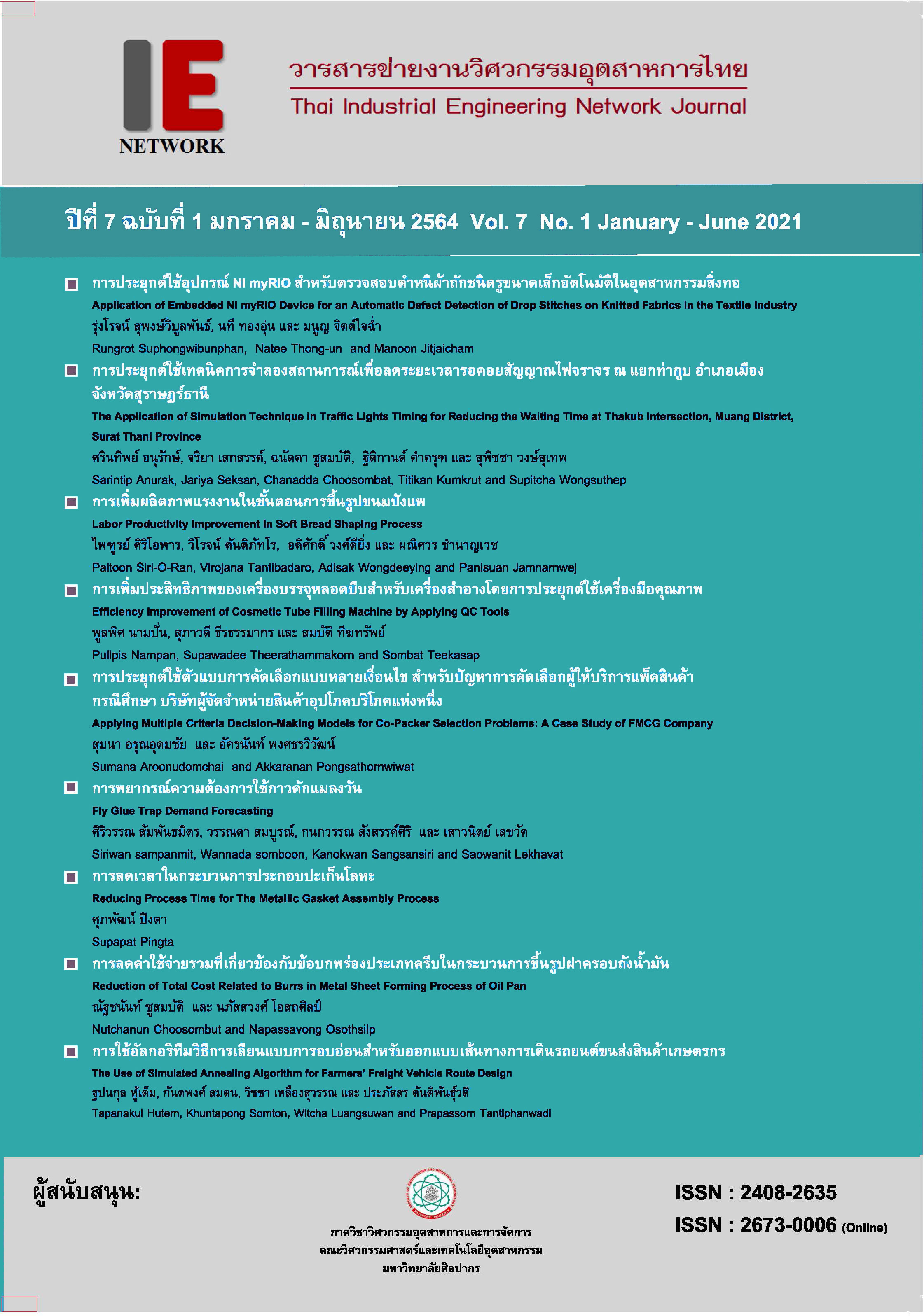The Use of Simulated Annealing Algorithm for Farmers’ Freight Vehicle Route Design
Main Article Content
Abstract
The research studied and utilized annealing algorithm to find optimal shipping routes in real traffic conditions for the area closed to Kasetsart University, Khamphaeng Saen campus. The objective was to find breakeven point and profit from the shipping routes. The study found that farmers sold their products to merchants who would buy their products at central markets. The selling price at the market was high, followed by high fuel costs of transportation. The researchers randomly collected data of product weights, distances and market times into three groups according to market segmentation as morning market, evening market and Chatchawan Imports and Packaging Ltd. A solution was created in order to transport the goods each time by using the simulated annealing (SA) method, coded with python language, applied to the problem which is divided into two models to find a good result under conditions at different time periods. Then all the solutions obtained are analyzed for the total cost, breakeven point and profit. The study found that the utilized annealing algorithms are able to provide the results of the vehicle route. The routes are ranked by weight and the number of vehicles used. Then taking the distance, weight and the number of vehicles to calculate for the break-even point. With the break-even point of 56,820,360.44 kg. within 5 years, the algorithm was able show the result of packing 38,739.12 kg/day. It is found that it will take 4.02 years to break even and generate a profit of 1,379.10 baht/day.
Article Details
บทความ ข้อมูล เนื้อหา รูปภาพ ฯลฯ ที่ได้รับการตีพิมพ์ในวารสารฯ ถือเป็นลิขสิทธิ์ของวารสารฯ หากบุคคลหรือหน่วยงานใดต้องการนำทั้งหมดหรือส่วนหนึ่งส่วนใดไปเผยแพร่ต่อหรือเพื่อกระทำการใดๆ จะได้รับอนุญาต แต่ห้ามนำไปใช้เพื่่อประโยชน์ทางธุรกิจ และห้ามดัดแปลง
References
[2] ทศพร ผงทอง, การวางแผนเส้นทางการขนส่งโดยใช้เซฟวิ่งอัลกอริทึม กรณีศึกษา เส้นทางการขนส่งขยะ อำเภอบางกรวย จังหวัดนนทบุรี [รายงานการวิจัย]. นนทบุรี; มหาวิทยาลัยราชพฤกษ์; 2559.
[3] นคร ไชยวงศ์ศักดา ประเวช อนันเอื้อ นิเวศ จีนะบุญเรือง เสกสรร วินยางค์กูล ขวัญเรือน สินณรงค์ ธนากร จักรแก้ว วุฒิชัย ใจบาล และ ณัฐวุฒิ ศรีสว่าง. การจัดเส้นทางการขนส่งโดยใช้เซฟวิ่งอัลกอริทึมและตัวแบบปัญหาการเดินทางของพนักงานขาย กรณีศึกษาโรงงานน้ำดื่ม. วารสารไทยการวิจัยดำเนินงาน. 2558; เล่มที่ 1: หน้า 51-61.
[4] มณิศรา บารมีชัย และ บุศรินทร์ ศรีสตรียานนท์. ปัจจัยที่มีผลต่อต้นทุนการขนส่งสินค้า. 2551 [เข้าถึงเมื่อ มิถุนายน 2563]. เข้าถึงได้จาก: https://www.iok2u.com/index.php/article/logistics-supply-chain/684-ct51-123.
[5] ระพีพันธ์ ปิตาคะโส. บทที่ 6 ปัญหาการจัดการเส้นทางขนส่ง. 2551 [เข้าถึงเมื่อ มิถุนายน 2563]. เข้าถึงได้จาก: https://silo.tips/download
/6-vehicle-routing-problems-vrp.
[6] ปิยรัตน์ งามสนิท ธรา อั่งสกุล และ จิติมนต์ อั่งสกุล. ขั้นตอนวิธีการจำลองการอบเหนียวสำหรับการวางแผนแผนการเดินทางท่องเที่ยวภายใต้เงื่อนไขบังคับด้านเวลา. วารสารวิทยาศาสตร์และเทคโนโลยี มหาวิทยาลัยมหาสารคาม. 2560; เล่มที่ 6: หน้า 713-727.
[7] สุคนธ์ทิพย์ สินวิวัฒนกุล นัทธพงศ์ นันทสำเริง และ สมบัติ สินธุเชาวน์. การประยุกต์อัลกอริทึมของวิธีเลียนแบบการอบอ่อนและวิธีเลียนแบบการเควนชิ่งสำหรับปัญหาพีมีเดียนโดยมีนโยบายราคาเข้ามาเกี่ยวข้อง กรณีศึกษาการหาสถานที่ตั้งโรงงานแป้งมันสำปะหลัง ในภาคตะวันออกเฉียงเหนือของประเทศไทย. วิศวกรรมสารฉบับวิจัยและพัฒนา. 2555; เล่มที่ 4: หน้า 61-70.
[8] กิตติภพ คนดี.การพัฒนาเทคนิคการกำหนดตำแหน่งติดตั้งโหนดอ้างอิงสำหรับระบบระบุตำแหน่งไร้สายภายในอาคารหลายชั้น [วิทยานิพนธ์ปริญญาวิศวกรรมศาสตรมหาบัณฑิต]. นครราชสีมา; มหาวิทยาลัยเทคโนโลยีสุรนารี; 2557.


